Complete Guide to Champagne | Wine 101
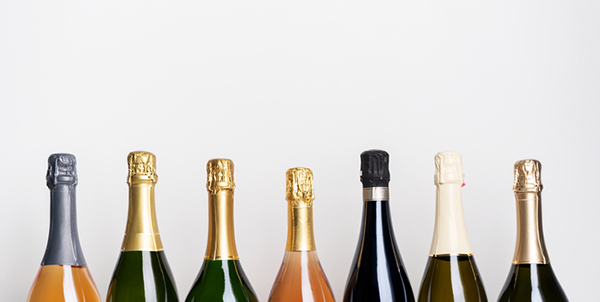
Champagne is, without a doubt, the most prestigious and iconic sparkling wine in the world.
Known for its delicacy, finesse, and unique balance of snappy acidity and creamy finish, it’s no wonder these wines command some of the highest prices possible.
With rigid standards and strict quality control, knowing about Champagne is like unlocking an entirely new world of wines to fall in love with.
In this guide, we’ll take a deep dive into the most sought-after sparkling wine in the world, along with food pairing suggestions, wine label reading tips, serving recommendations, plus some excellent expressions to try!
Characteristics of Champagne
Champagne is, in its essence, an exceptional sparkling wine made in the Champagne region of France, 90 miles northeast of Paris.
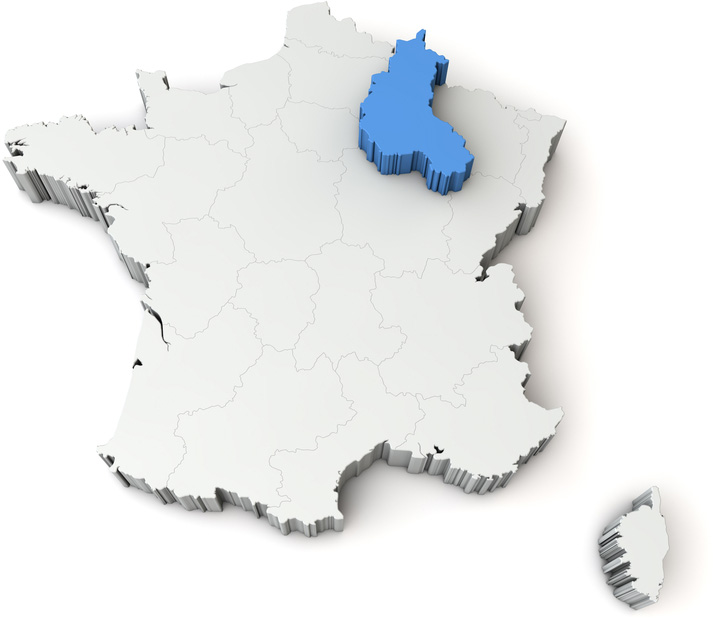
Map of France Highlighting Champagne Region
Its flavor and quality vary drastically depending on where the vineyard's location and winemaking practices.
There are three permissible grapes to be used to make Champagne: Chardonnay, Pinot Noir, and Pinot Meunier - the latter of which is a distant clone of Pinot Noir.
A combination of one, two, or all three grapes are permitted to make Champagne, with some combinations more sought after than others.
Champagne is light-bodied, low in alcohol (11-12%), and high in acid. As for sweetness, Champagne can be made anywhere from sweet to extra dry to brut nature.
Champagne Tasting Notes
Champagne can vary in flavor depending on the concentration of the three grapes used, whether it is golden or rosé Champagne and the quality of the grapes used.
Champagne can be expected to have crisp flavors of lemon, apple, brioche, cream, and toast. Flavors of nuts and honey are common with some aging. Its bubbles are subtle but persistent, with tiny bubbles being the ideal.
Champagne made primarily with Chardonnay is known as gold Champagne and will have a more crisp citrus and green fruit flavor.
Champagne made with Pinot Noir and Pinot Meunier will have more emphasis on body and fruit.
Rosé Champagne will have more strawberry and red cherry flavor.
As for quality, higher-quality Grand cru and Premiere cru Champagne will have more bready and creamy flavors, as these wines are usually aged for longer.
Keep reading to learn more about Champagne crus.
Related: How does Champagne compare to other sparkling wines like Prosecco?
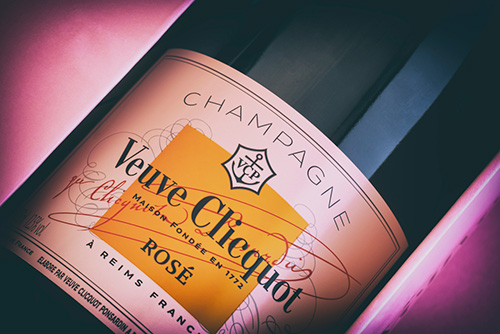
How is Champagne Served?
Champagne is best served well-chilled, around 38°-45°F in a tulip or flute Champagne glass, ideally, one with a slightly wider bulb at the base to allow for the aroma to develop.
Keep in mind that Champagne bottles are thicker than normal wine bottles, so they will need to chill for longer before serving.
The Champagne Grapes
Champagne’s history began in the Roman era, though it wasn’t until the middle ages that this region became so highly regarded. Funny enough, Champagne’s history and prestige were largely accidental.
Due to Champagne’s cold climate, where daily temperatures rarely exceed 50°F, wines were made in the fall and left to rest over winter. This froze the yeast in place until temperatures warmed up, at which point the yeast sprung back to life, making slightly bubbly wine.
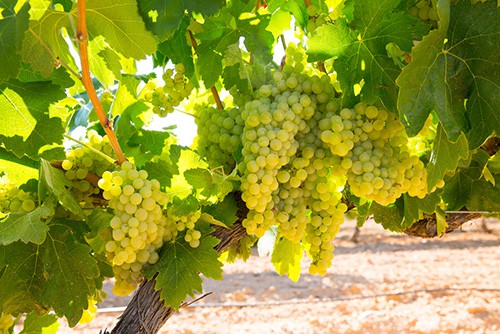
Chardonnay grapes
The resulting bubbly wine with extended lees (yeast) contact originally disturbed its winemakers, who lacked modern fermentation knowledge. When the British began importing their wines (they loved the wine’s sweet taste and the celebratory bubbles), the Champagne makers realized they had something valuable.
Today, Champagne is one of the most expensive wines in the world. As mentioned above, three grapes are permitted to be used to make Champagne: Chardonnay, Pinot Noir, and Pinot Meunier.
Champagne of the highest quality typically has no Pinot Munier, while the most expensive Champagnes are actually made in the rosé style, with a combination of Chardonnay and Pinot Noir.
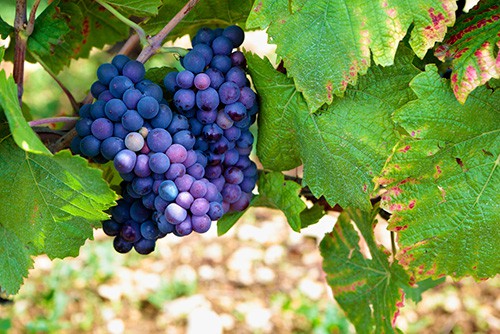
Pinot Noir grapes
Méthode Traditionnelle
Part of Champagne’s notoriety has to do with the way these wines are made, in the méthode traditionnelle, also known as the “Champagne method,” or “méthode champenoise.”
This method involves taking a dry base wine and transferring it to bottles to undergo secondary fermentation, creating bubbles. While sealed, these bottles are then “riddled” or held at an angle and turned daily (often by hand) until all of the yeast in the bottle collects at the opening.
Once secondary fermentation is complete, the bottles are “disgorged,” so the yeast is removed and the wine remains clear. This is done by rapidly flash-freezing the head of the bottle, which freezes the yeast to the cork.
Then the cork is removed, and a tiny bit of sugar is added to the bottle before it is recorked. Amazingly enough, the entire disgorging practice takes just a couple of seconds.
As for that tiny bit of sugar added, that is referred to as the wine’s “dosage” and indicates the wine's level of sweetness.
Champagne Labeling Terms
Wine labels can often be the biggest hurdle to overcome when perusing your local wine aisle. Luckily, there are a few terms you should know in order to make the perfect Champagne selection.
Grapes Used
Depending on the grapes used, the Champagne may be labeled as Blanc de Blancs, Blanc de Noirs, or Rosé Champagne.
Blanc de Blancs Champagne is made entirely from the Chardonnay grape and is treasured for being light, refreshing, feminine, and snappy on the palate. The premiere growing regions are planted almost exclusively with Chardonnay. This is the most common style of Champagne and can be quite expensive.
Blanc de Noir Champagne is much less common and is made only with Pinot Noir and Pinot Meunier. While slightly pink in color, it is not technically a rosé. This style is more commonly found in California sparkling wines made in the méthode champenoise style.
Rosé Champagne is the most expensive style of Champagne, as they are richer and more full in body than golden Champagne. Rosé Champagne is made either by letting the base wine sit with the Pinot skins or by adding still Pinot Noir to the dry base wine. Despite its color, Rosé Champagne is often a blend of mostly Chardonnay.
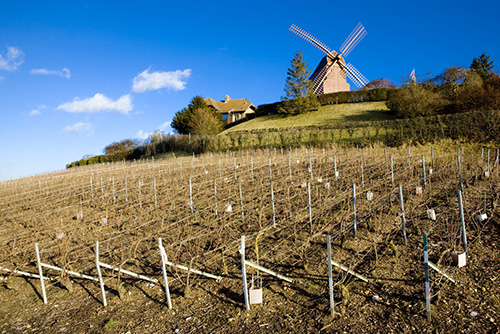
Vineyard near Verzenay in the Champagne region
Quality
Four common labels can be identified on all bottles of Champagne and can be more indicative of their quality: Non-Vintage (NV), Vintage, Premiere Cru, or Grand Cru.
Non-Vintage Champagne is a blend of dozens - even hundreds - of base wines from “good” vineyards that get combined to make a uniform blend. Pinot Meunier is almost always included. These wines are typically aged for at least 15 months sur lie (with lees contact).
Vintage Champagne is only made in exceptional growing years and is a blend of dozens of base wines from “good” to “great” vineyards over just a single year. Pinot Meunier will sometimes be included. A minimum of three years sur lie is required.
Prestige Cuvée will be labeled either Premiere Cru or Grand Cru, with Grand Cru being the highest quality Champagne available. Pinot Meunier is rarely included. While there’s no aging requirement, common practice is between 4-10 years sur lie.
Related: How long does unopened Champagne keep for?
What are Champagne 'Crus'?
French wine classification is particularly complicated. The word 'cru' can actually have different meanings depending on the region of France and the wine varietal in question.
When talking about Champagne, a 'cru' is a village where the grapes are grown. The system was set up in 1919 to fix Champagne grape prices before being sold to the Champagne houses where the wine is made. The system is no longer in operation but the labeling is still used.
In 2023, there are 17 villages given Grand Cru status and 42 villages labelled Premier Cru. Grand Cru Champagne is considered more desirable because it is from such a small, restricted area. Some famous villages labelled Grand Cru are Bouzy, Oger, and Cramant.
Today, the label is used as a promotional tool by the growers that are lucky enough to have vineyards within these villages. You always pay extra for Champagne from one of these villages.
Historically, these grapes are considered to be of exceptional quality but that's not always the case these days. Incredible Champagne simply does not need to be Premier or Grand Cru. But, Champagne is all about prestige and branding so these labels matter a lot to some people.
Champagne Sweetness Scale
Depending on the “dosage” or amount of sugar added just before finishing the wine, Champagne can be found in all sweetness levels. Here’s a quick breakdown:
Champagne Food Pairings
Champagne is ideal for all sorts of food pairings. With high acidity, low alcohol, and refreshing effervescence, Champagne pairs beautifully with everything from rich cream sauces to deep-fried dishes.
In general, it is best to avoid richly-flavored dishes such as prime rib, as these can mask the subtle and fresh flavors of Champagne.
Awesome Champagne to Try
We usually try to include a 'budget' option in this section but it's a hard thing to do with Champagne! I'm afraid it's just a wine that commands top dollar. Costco offers some of the best value Champagne you can find.
Under $50 - Piper-Heidsieck Cuvee Brut

This Non-Vintage Champagne is made in a dry, brut style, composed of 50% Pinot Noir, 30% Pinot Munier, and 20% Chardonnay. The resulting wine is wonderfully refreshing, full, and balanced. Flavors are rich with summertime fruit, almond, and subtle toasted flavors.
Under $100 - Laurent-Perrier Cuvee Rose
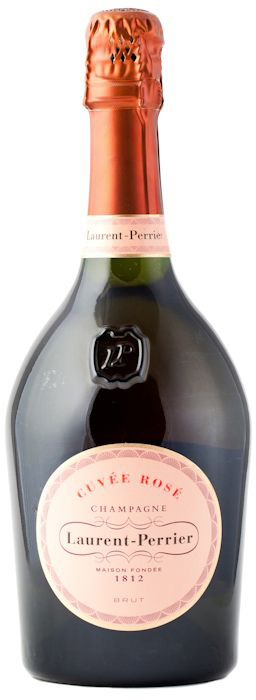
This Champagne is made in a rosé style from 100% Pinot Noir grapes, resulting in a vibrantly pink wine with lush red fruit and floral aromas. It’s rich with fleshy red cherry and strawberry flavors and ends with a delightfully creamy finish.
Interesting Facts About Champagne
- A standard bottle of Champagne contains about 49 million bubbles.
- A Champagne cork can reach up to 24.8 miles per hour when popped.
- Champagne has about three times more carbonation than beer.
